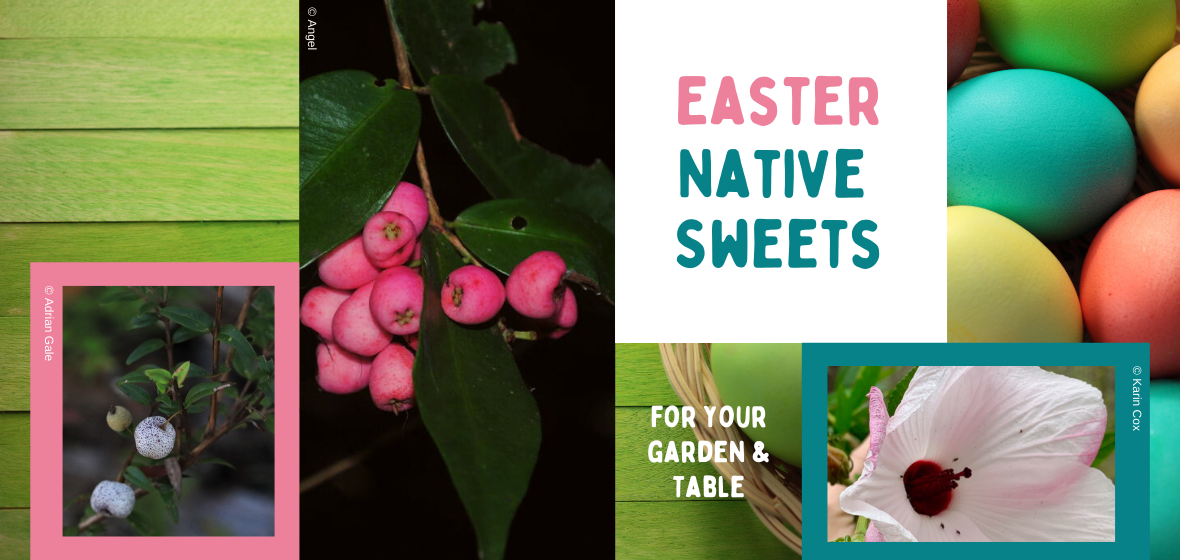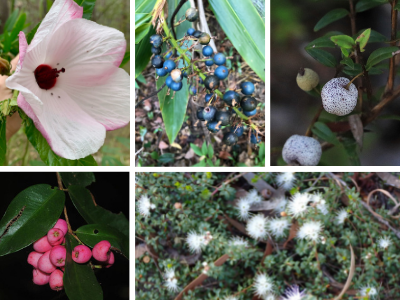14 April 2021
It’s a dentist’s favourite time of year. Kids get a long break and a sugar rush, and parents get … well … let’s just say we might need a spell in the garden!
Of course, we don’t expect Aussie natives will ever topple the world’s favourite Easter plant – Theobroma cacao, the giver of chocolate. But consider supplementing it with some edible local delicacies this year.
Many native species not only produce tasty fruits or roots that can enhance your cooking but also appeal to our wildlife friends, whether bats, birds, or possums, as well as keeping native pollinators in business.
Tasty native treats like midyim, muntries, or rosella jam are excellent local alternatives, and we have just the planting program to keep your homelife sweet over the holidays.
7 native plants and fruits to sweeten up your garden (and your Easter menu)
Muntries (Kunzea pomifera). Although native to South Australia, muntries are available as a horticulture species and will grow in well-drained, drier areas of Queensland with a little care. Also known as emu apples or crab apples, the reddish-green to purplish berries that appear on this woody creeper ripen in autumn, are astonishingly high in antioxidants, and were a known favourite of the Narrindjeri people of South Australia. These crunchy berries can be made into a delicious, apple-tasting filling for tarts. Muntries are grown commercially in the southern states, so if you can’t get your hands on a plant, you can try to buy some berries fresh from February to late March. Click here to learn more.
- Midyim (Austromyrtus dulcis) is easier to grow in Queensland’s South East, as it is endemic to the region. This shrubby bush, also known as ‘tucker bush’, produces star-shaped white flowers and, in late summer and autumn, small white berries that are adorably purple-speckled, like little bird’s eggs, adding a lovely aesthetic to any dish when left whole. Regarded as one of the most delicious bush fruits, midyim berries’ sweet pulp appealed to Indigenous people and early settlers alike. Click here to learn more.
- Riberry (Syzygium luehmannii). Red cordial is known to make kids hyper, which nobody needs more of at Easter, so why not substitute with a refreshing lilly pilly cordial made of riberries? Australia is fortunate to have several edible lilly pilly species that grow along the east coast. Indeed, these berries were among the first edible fruits recorded by James Cook. Among Australia’s lilly pilly species, ribberies currently have the most commercial viability. These pretty red berries with a white pulp have quite a tang, but with a little added sweetener of your choice, they make a refreshing drink. Riberries can also be made into a fruit pulp for cheesecakes or a syrup or ‘jus’ to accompany meat.
- Native ginger (Alpina caerulea). If you’re a strictly no meat at Easter person (or ever!), a flavoursome savoury-sweet accompaniment to fish or veggies can be made from the native ginger plant. This species also grows a blue fruit that isn’t particularly palatable, as it has lots of seeds, but its underground tubers (or rhizomes) can be sliced, boiled, and sweetened to make zingy, gingery sauce. Click here to find out more.
- Native finger limes. If seafood is on the menu, or if you’re a fan of lemon meringue tarts, also consider the zesty, popping, citrus sensation of native finger limes. Australia has four species of this delicacy in the genus Microcitrus. While not sweet, M. australasica particularly has become a darling of high-end restaurants around the globe for its bead-like burst of citrus ‘caviar’. Each tiny bubble of flavour packs an outsized punch, so a little finger lime goes a long way. Click here to find out more.
- Native rosella (Hibiscus heterophyllus). One of grandma’s favourites, rosellas are native hibiscuses with glorious flowers and tartly tasty buds that are used to make jam with a rich, fruity, rhubarb-like flavour. The buds can also add crunch to salads and make an eye-catching garnish. Click here to find out more.
- Native honey. While not a plant, of course, a native honey beehive in the garden is just the thing to sweeten up that riberry cordial or native ginger glaze while keeping it all-natural and all-Australian. Several native stingless native bee species produce honey, but three of the best for Queensland beekeepers are Tetragonula carbonaria, Austroplebeia australis and Tetragonula hockingsi (if you are north of Gympie). Several businesses have native beehives and products for sale, but remember that it is an ongoing commitment to care for these little sweeties who do the good work of pollinating all those native plants you’ve added.
And if all of the above seems like too much cooking and gardening at this time of the year, well, there’s also that old favourite: good old Aussie macadamia nuts (Macadamia tetraphylla) dipped in honey or in that sweet, sweet South American serotonin – chocolate.
Or, at the very least, pop into Woollies to support the Australian Bilby Foundation by purchasing a Darrell Lea easter bilby from Woolworths or Big W (20c from the sale of each bilby to the Save The Bilby Fund) or to Coles to buy Puddles the Platypus, which helps out the Australian Platypus Conservancy.
Where to source native plants
Many nurseries throughout Queensland and online now have a dedicated section for edible native plants. Here in South East Queensland, we love Indigiscapes Native Nursery in the Redlands, which sells native tubestock for just $2 and also stocks birdwing butterfly vines (Pararistolochia praevenosa), aiding our Richmond Birdwing Conservation Network’s efforts to save this butterfly.
Whether you spend it in the kitchen, in the garden, in the bush camping with family or friends, or quietly absorbed by the wonder of your new native beehive, we wish you a very Happy Easter.
Images: Clockwise from top: Rosella flower (Image: Karin Cox); native ginger (Image: Tim Shields); midiym (Image: Adrian Gale), muntry bush (Image: Geoffrey Cox), and riberry (Image: Angel/iNaturalist).


 Muntries (Kunzea pomifera)
Muntries (Kunzea pomifera)